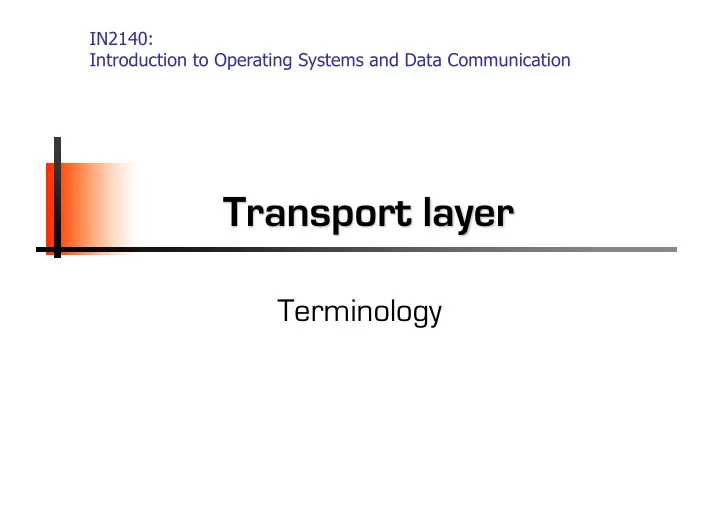

IN2140: Introduction to Operating Systems and Data Communication Transport layer Terminology
Terminology: bandwidth (1/2) Mirriam-Webster online ( http://www.m-w.com ): Traditional, “real“ definition! § Main Entry: band*width, Pronunciation: 'band-"width Function: noun, Date: circa 1937 − 1 : a range within a band of wavelengths, frequencies, or energies; especially : a range of radio frequencies which is occupied by a modulated carrier wave, which is assigned to a service, or over which a device can operate − 2 : the capacity for data transfer of an electronic communications system <graphics consume more bandwidth than text does>; especially : the maximum data transfer rate of such a system “Information rate“ § Unit: definition 1 - “Hz“, definition 2 - “bit/s“ (bps) § Common terminology in computer network context: How many bits/sec can be transferred = “how thick is the pipe” University of Oslo IN2140 – Introduction to operating systems and data communication
Terminology: bandwidth (2/2) § Various wooly “bandwidth“ terms − Nominal bandwidth: Bandwidth of a link when there is no traffic − Available bandwidth: (Nominal bandwidth - traffic) ... during a specific interval − Bottleneck bandwidth: smallest nominal bandwidth along a path, but sometimes also smallest available bandwidth along a path § Throughput: bandwidth seen by the receiver § Goodput: bandwidth seen by the receiving application − e.g. TCP: goodput != throughput − Difference is not only message headers - more required to ensure reliability, ordering, flow control, congestion control, ... University of Oslo IN2140 – Introduction to operating systems and data communication
Terminology: delay § Propagation delay - time to transfer a bit § Latency = propagation delay + msg_length / bottleneck bandwidth + queuing delay − just a rough measure; e.g., processing delay can also play a role, esp. in core routers (CPU = scarce resource!) § Jitter - delay fluctuations, very critical for most real-time applications § End-to-end delay – time a message needs from a sending entity to a receiving entity − end-to-end delay on the application layer includes TCP retransmissions − end-to-end delay on the transport layer does not § Round-trip time (RTT) - time a messages needs to go from sender to receiver and back University of Oslo IN2140 – Introduction to operating systems and data communication
IN2140: Introduction to Operating Systems and Data Communication Transport layer TCP reliability
TCP Reliability • TCP/IP has only two tools for ensuring reliable transfer: • detecting duplicate byte ranges • retransmitting data that has not arrived and not arrived correctly University of Oslo IN2140 – Introduction to operating systems and data communication
TCP Reliability • TCP/IP Retransmits segments until they are acknowledged • ACK field is used for that Version IHL Type of service PRE ToS Total length Identification D M Fragment offset Time to live Protocol Header checksum IP header Source address Destination Address Options Source port Destination port Sequence number Piggyback acknowledgement TCP header THL unused U A P R S F Window Checksum Urgent pointer Options (0 or more 32 bit words) Data Acknowledgement: Indicator: Next expected byte Is the ACK field in use University of Oslo IN2140 – Introduction to operating systems and data communication
TCP ACK and Reliability S e q Timer = 9 2 , Seq=92, 8 bytes data 8 b y t e s start d a t a S e Timer for 92 q = ACK=100 1 0 0 , 2 0 b y X t e Timer for 100 s Loss! d a t a ACK=100 0 2 1 = K C A S e Timeout! q = 9 2 , S 8 e q b = y 9 t e 2 s , d 8 a b t a y t e s S d a e t a q Timeout! = 1 2 0 , 1 0 b ACK=100 y t e s 0 d 2 1 a = t K a C A time time time time Timeout retransmission Spurious retransmission In modern TCP implementations, a lot is done to suppress spurious retransmissions. The reason is that timeouts have another meaning: congestion University of Oslo IN2140 – Introduction to operating systems and data communication
TCP Round trip time and timeout § How to set the retransmission timer? − Must be longer than round-trip time (RTT) − Too short: many spurious retransmissions − Too long: slow reaction, flow control buffer fills up § Idea − Estimated RTT • Use a SampleRTT: Measure time from segment sending and ACK received • Compute EstimatedRTT as a floating average • Increase the EstimatedRTT with a safety margin that is big when SampleRTT changes a lot § (because fewer timeouts are considered better) Not only 1 RTT because we have also “Fast Retransmission” for fixing packet loss, explained with “Congestion” University of Oslo IN2140 – Introduction to operating systems and data communication
Recommend
More recommend